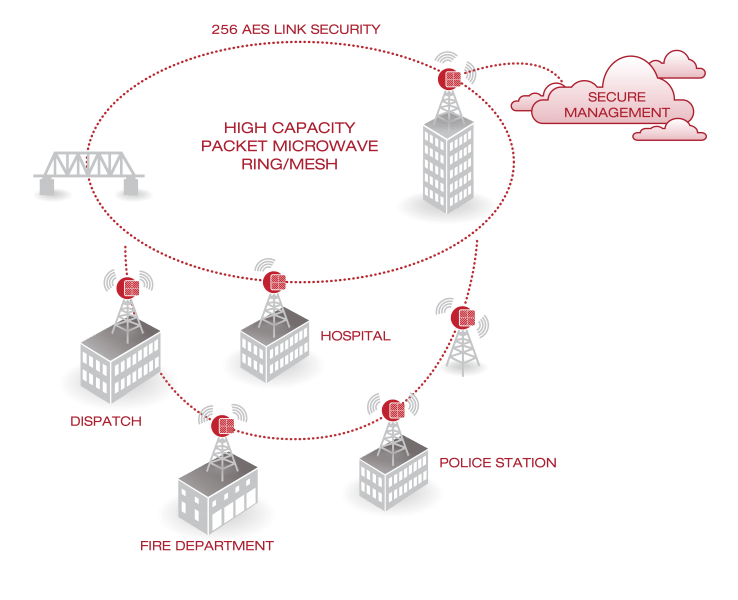
By Erik McLaughlin, DragonWave
The introduction of dedicated 700 MHz LTE spectrum for public-safety agencies is driving major changes as new applications require much higher levels of backhaul capacity. The 700 MHz LTE network overlay lets public-safety agencies support data-intensive applications that include —but are not limited to— video surveillance, high-speed Internet access, video conferencing and IP voice services.
The all-IP infrastructure ensures a common ground for inter-agency communication. The current generation of IP-based radios deliver solutions?ranging from tens of Mbps to multi-Gbps?that address public-safety networks? capacity needs and offer secure end-to-end communication for mission-critical applications.
Outdoor-based public-safety infrastructure systems, such as security cameras, secure Wi-Fi access points, and LTE, can sometimes be placed on non-telecom infrastructure (i.e., traffic lights, street lights, etc.) where fiber or other wireline backhaul transport options may not be readily available. These sites also are constrained in terms of cabling and power. This type of site infrastructure presents unique challenges, primarily from the amount of space available for backhaul and the security of the site.
To address these challenges, microwave is an attractive lower-cost option, as well as an alternative that meets the performance and reliability criteria defined by public-safety network operators. The latest all-outdoor microwave radios combine both the modem and RF into a single unit?removing any requirement for indoor shelter space?and these radios use 60% to 90% less power than traditional split-mount or all-indoor systems. A viable microwave solution must be capable of addressing the capacity, resiliency, and security requirements of public-safety network operators.
Capacity Scalability, and Resiliency
The introduction of LTE for public-safety networks brings new data-centric applications that coexist with voice services, such as live video feeds and other high-speed data applications. This increased site capacity requires a scalable backhaul solution that can meet the increasing network demands.
Microwave radios solutions from 10 Mbps to N x Gbps incorporate 2048QAM, advanced compression techniques, and wider channels, so capacities are now reaching and surpassing gigabit levels on a single radio, thus delivering sufficient scalability for public-safety applications.
Adaptive modulation lets radios maintain up time during changing environmental conditions and preserve critical services using Ethernet?s Quality of Service (QoS) mechanism to ensure that high-priority services are maintained. Radios with integrated advanced Ethernet switching can deliver resilient ring/mesh topological network connections without the use of an external switch/router. Ring/mesh-based architectures provide a distinct advantage over hub-and-spoke systems, in that they provide path redundancy and hardware protection to deliver a resilient networking solution.
Secure Communication
Using a dedicated co-located appliance to deliver end-to-end security poses challenges, due to the lack of available shelter space. All-outdoor microwave systems with integrated security capability can deliver management security to provide secure entry through local or remote access to the system. These systems should have:
Secure Shell (SSH) for secure Web communications. Most microwave systems these days use a web-based graphical user interface (GUI) to configure, manage, or troubleshoot the device.
Secure Sockets Layer (SSL) for securing Telnet sessions. This improves the security of remote Telnet sessions for operators using command-line interfact (CLI) to configure their devices.
Remote Authentication Dial In User Service (RADIUS) or Terminal Access Controller Access-Control System Plus (TACAS+). Both options provide a central authentication of users for management access into the system.
SNMPv3. Simple Network Management Protocol (SNMP) is a common used protocol to communicate with higher-layer element management systems. Version 3 introduced greater cryptographic security through strong authentication and data-encryption abilities.
These microwave features address management security, but there are also cases where the public-safety network operator is looking for additional security measures. Even though microwave links are inherently secure, through a combination of pencil-thin beam widths and radio-to-radio authentication, there are locations that may have a potential for wireless snooping. Some microwave solutions available today provide full payload encryption, with 256 AES encryption commonly seen as the de facto method used.
The National Institute of Standards and Technology (NIST) issued the FIPS 140 Publication Series to coordinate the requirements of cryptography modules and systems, including microwave systems. A full list of validated FIPS 140-2 systems, can be found at http://csrc.nist.gov/groups/STM/cmvp/documents/140-1/140val-all.htm
In summary, all-outdoor microwave backhaul systems deliver the key elements needed for the transport layer of an outdoor-based LTE system. Next-generation, all-outdoor microwave radios offer the essential combination of having a small form factor with high scalability for LTE and data-rich applications, the resiliency to meet the service level agreements (SLAs) of mission-critical services, and FIPS certification to ensure the highest level of security.
Source: dragonwaveinc.com
